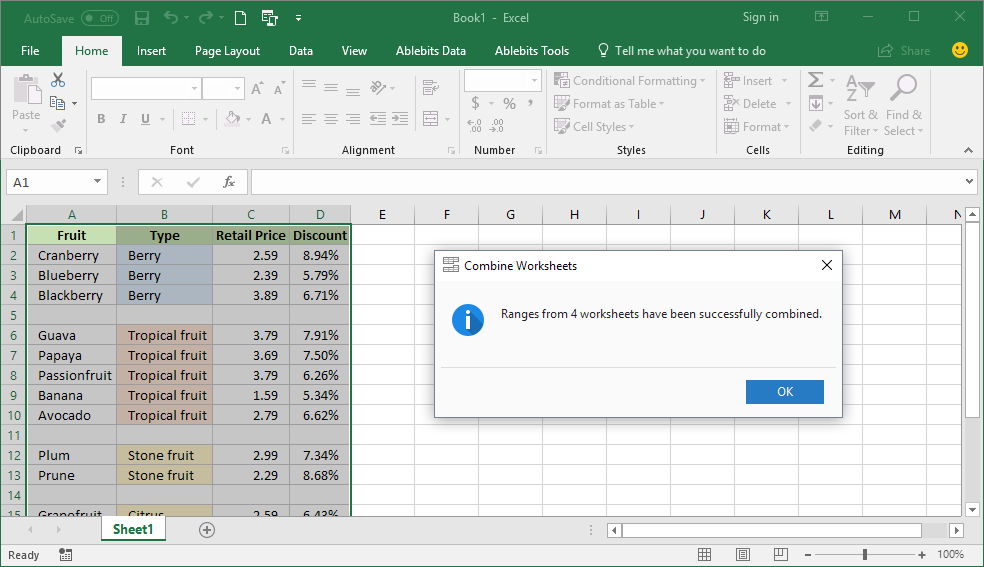Merge Multiple Excel Files into One Sheet Easily

Dealing with multiple Excel files can be a hassle, especially when you need to consolidate data from various sources into a single sheet for analysis, reporting, or just to keep your data organized. Fortunately, there are several straightforward methods to merge multiple Excel files into one sheet, which we will explore in this comprehensive guide. Whether you're using Microsoft Excel, Google Sheets, or even looking into automation with Python or VBA, we've got you covered.
Using Microsoft Excel

Microsoft Excel provides native tools that allow you to consolidate data from multiple workbooks into one master file. Here’s how you can do it:
1. Manual Copy and Paste

- Open all the Excel files you wish to merge.
- In your destination workbook, select the cell where you want to start pasting the data from other files.
- Switch to the first source workbook, select the range of data you need, copy it (Ctrl+C), then switch back to your destination workbook and paste (Ctrl+V).
- Repeat the process for each workbook.
⚠️ Note: This method is practical for small datasets but becomes time-consuming and error-prone with large volumes of data.
2. Power Query

Power Query, available in Excel 2016 and later versions, is an incredibly powerful tool for data manipulation:
- Go to the Data tab, and click on Get Data > From File > From Workbook.
- Select the first Excel file to import. Excel will open the Power Query Editor.
- In the Query Editor, you can transform the data as needed, then load it into your workbook.
- To add more files, click on Home > Append Queries, choose Three or more tables, and navigate to the other Excel files.
Power Query will automatically merge these into one table. You can then refresh this query anytime new data needs to be appended.
3. Using VBA to Automate the Process

Visual Basic for Applications (VBA) can automate repetitive tasks in Excel. Here’s a basic script to get you started:
Sub MergeFiles()
Dim FolderPath As String
Dim FileName As String
Dim WS As Worksheet
Dim LastRow As Long, LastColumn As Long
FolderPath = "C:\YourFolderPath\"
FileName = Dir(FolderPath & "*.xlsx")
'Create new workbook or use existing one
Set WS = ThisWorkbook.Sheets("MasterData")
Do While FileName <> ""
With Workbooks.Open(FolderPath & FileName)
.Worksheets(1).UsedRange.Copy WS.Range("A1")
.Close False
End With
'Find last used row in the destination sheet
LastRow = WS.Cells(WS.Rows.Count, "A").End(xlUp).Row
LastColumn = WS.Cells(1, WS.Columns.Count).End(xlToLeft).Column
'Move to next file
FileName = Dir
Loop
End Sub
💡 Note: Ensure that all your source workbooks are formatted similarly to avoid issues when copying data.
Using Google Sheets

Google Sheets is another robust platform for managing Excel-like data:
1. Import Multiple Files

- Open a new Google Sheet.
- Go to File > Import.
- Choose Upload or select files from your Google Drive. You can upload multiple files at once by holding the Ctrl (Windows) or Command (Mac) key.
- Select Create new spreadsheet, Insert new sheet(s), or Replace current sheet.
- Click Import data and ensure the data is set to be appended rather than replaced.
2. Using Google Apps Script

You can use Google Apps Script to automate the merging process:
function mergeFiles() {
var folder = DriveApp.getFolderById("YourFolderID");
var sheet = SpreadsheetApp.getActiveSpreadsheet().getSheetByName("Sheet1");
var files = folder.getFiles();
while (files.hasNext()) {
var file = files.next();
if (file.getName().endsWith(".xlsx")) {
var spreadsheet = SpreadsheetApp.openByUrl(file.getDownloadUrl());
var sheet = spreadsheet.getSheets()[0];
var data = sheet.getDataRange().getValues();
var lastRow = sheet.getLastRow() + 1;
var lastColumn = sheet.getLastColumn();
sheet.getRange(lastRow, 1, data.length, lastColumn).setValues(data);
}
}
}
Remember to replace "YourFolderID" with the ID of the folder containing your files.
Python for Data Merging

Python, with libraries like `pandas`, offers a programmatic approach to merge Excel files:
1. Using Pandas

- Install pandas if not already done:
pip install pandas openpyxl - Here’s a script to merge files:
import pandas as pd
import os
# Get the directory containing the Excel files
directory = r'C:\your\directory\'
files = [f for f in os.listdir(directory) if f.endswith('.xlsx')]
# Initialize an empty DataFrame to hold the merged data
merged_data = pd.DataFrame()
for file in files:
df = pd.read_excel(os.path.join(directory, file))
merged_data = pd.concat([merged_data, df], ignore_index=True)
# Save the merged data to a new Excel file
merged_data.to_excel('merged_output.xlsx', index=False)
Python's scriptability allows for more complex merges, including joining on specific columns or handling headers differently.
Summary

The ability to merge multiple Excel files into one sheet is a valuable skill in data management, allowing for streamlined analysis, reporting, and data organization. Whether you choose the manual methods in Microsoft Excel, utilize automation via VBA or Google Apps Script, or leverage Python's data manipulation capabilities, there's a solution that fits your technical proficiency and specific needs. Each method provides flexibility and efficiency, catering to different levels of complexity and automation in data consolidation.
By mastering these techniques, you not only enhance your productivity but also gain a powerful toolset for dealing with data from multiple sources efficiently.
Can I merge files with different headers?

+
Yes, but you might need to manually adjust or map the headers in the destination sheet or use programming to normalize the headers before merging.
What if the data in my files has duplicate entries?

+
You can use the Remove Duplicates feature in Excel or use a tool like Pandas in Python to handle duplicates during or after the merge.
Can I automate merging on a schedule?

+
Yes, with tools like Python, VBA, or Google Apps Script, you can set up scheduled tasks or triggers to merge files automatically at specified times or intervals.